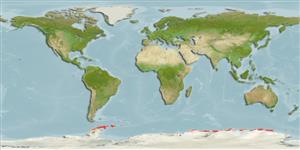Elasmobranchii (Haie und Rochen) (sharks and rays) >
Rajiformes (Skates and rays) >
Arhynchobatidae (Softnose skates)
Etymology: Bathyraja: Greek, bathys = deep + Latin, raja, -ae = a ray (Raja sp) (Ref. 45335).
Environment: milieu / climate zone / depth range / distribution range
Ökologie
seewasser demersal; tiefenbereich 91 - 500 m (Ref. 5179). Polar; 48°S - 65°S, 79°W - 84°E
Southern Ocean: Orkney and South Shetland islands to the Antarctic Peninsula. Probably more widespread in continental waters into the Weddell Sea and eastward as well as into the Pacific Ocean sector westward. Southeast Pacific: Chile (Ref. 9068).
Size / Gewicht / Alter
Maturity: Lm ? range ? - ? cm
Max length : 120 cm TL Männchen/unbestimmt; (Ref. )
Oviparous. Distinct pairing with embrace. Young may tend to follow large objects, such as their mother (Ref. 205). Eggs are oblong capsules with stiff pointed horns at the corners deposited in sandy or muddy flats (Ref. 205). Egg capsules are 15.66 cm long and 8.0 cm wide (Ref. 41249). Regularly taken as bycatch in trawl hauls and may be used as fishmeal. Minimum depth from Ref. 58018.
Life cycle and mating behavior
Geschlechtsreife | Fortpflanzung | Ablaichen | Eier | Fecundity | Larven
Oviparous, paired eggs are laid. Embryos feed solely on yolk (Ref. 50449). Distinct pairing with embrace. Young may tend to follow large objects, such as their mother (Ref. 205).
McEachran, J.D. and K.A. Dunn, 1998. Phylogenetic analysis of skates, a morphologically conservative clade of elasmobranchs (Chondrichthyes: Rajidae). Copeia 1998(2):271-290. (Ref. 27314)
IUCN Rote Liste Status (Ref. 130435)
Bedrohung für Menschen
Harmless
Nutzung durch Menschen
Fischereien: kleinfischerei
Mehr Information
Alter/GrößeWachstumLänge-GewichtLänge-LängeLängenhäufigkeitenMorphometrieMorphologieLarvenLarven Pop.Dyn.RekrutierungDichteBRUVS
ReferenzenAquakulturAquakultur ProfilZuchtlinienGenetikElectrophoresesVererbbarkeitKrankheitenVerarbeitungNutrientsMass conversion
Tools
Zusatzinformationen
Download XML
Internet Quellen
Estimates based on models
Preferred temperature (Ref.
123201): -1.4 - 1.2, mean -0.2 °C (based on 89 cells).
Phylogenetic diversity index (Ref.
82804): PD
50 = 0.5000 [Uniqueness, from 0.5 = low to 2.0 = high].
Bayesian length-weight: a=0.00525 (0.00319 - 0.00862), b=3.12 (2.98 - 3.26), in cm total length, based on LWR estimates for this species & Genus-body shape (Ref.
93245).
Trophic level (Ref.
69278): 4.0 ±0.7 se; based on size and trophs of closest relatives
Widerstandsfähigkeit (Ref.
120179): niedrig, Verdopplung der Population dauert 4,5 - 14 Jahre. (Fec assumed to be <100).
Fishing Vulnerability (Ref.
59153): High to very high vulnerability (72 of 100).
Climate Vulnerability (Ref.
125649): Very high vulnerability (90 of 100).
Nutrients (Ref.
124155): Calcium = 6.04 [1.09, 30.37] mg/100g; Iron = 0.282 [0.065, 0.876] mg/100g; Protein = 15.8 [13.3, 18.4] %; Omega3 = 0.46 [0.15, 1.81] g/100g; Selenium = 12.6 [3.8, 40.9] μg/100g; VitaminA = 8.31 [1.82, 39.43] μg/100g; Zinc = 0.293 [0.145, 0.539] mg/100g (wet weight);
